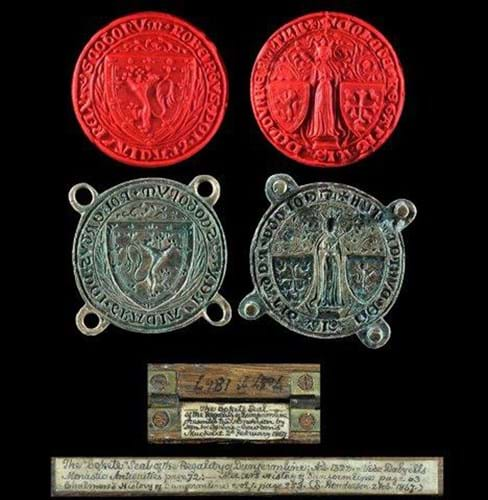
The seal matrices are due to be exported from the UK after a sale at Timeline Auctions in December 2014 for £125,000 (£151,250) including premium).
The front is engraved with St Margaret, Dunfermline Abbey’s founding saint, and the reverse bears the royal arms of Scotland.
It carries a Lombardic legend Robertvs Dei Gracia Rex Scotorvm that translates as “Robert, by the Grace of God, King of the Scots”.
It is thought that the seal matrix pair could date back to the reign of Robert I (1306-29) although some experts believe it could be a later replica of a lost original from the late Middle Ages.
The seal was purchased in the 19th century by erstwhile owner Dr Ebenezer Henderson (1800-79) whose Annals of Dunfermline were published in the last year of his life. Timeline's vendor was 'a London gentleman'.
It was previously subject to an export deferral in 2016, which was suspended to allow new information about its history to be considered.
Outstanding Importance
Leslie Webster, a member of the Reviewing Committee on the Export of Works of Art and Objects of Cultural Interest (RCEWA), said: “This remarkable two-part seal matrix is unique, and if it indeed dates to the reign of Robert the Bruce (1306-29) it is an item of outstanding importance, as one of the few objects directly associated with his reign, a decisive period in the history of the Kingdom of Scotland.
“An alternative possibility, that it might be a later copy of a lost original, does not diminish its considerable significance for the study of medieval seal-dies, and opens up new avenues of research.’
The decision on the export licence application for the seal will be deferred until November 24. This may be extended until 24 February 2018 if a serious intention to raise funds to purchase it is made at the recommended price of £151,250.
King Robert I, who died in 1329, had a longstanding connection with Dunfermline Abbey and was buried there (his tomb was lost for centuries but rediscovered in 1818). His heart, however, was taken on crusade by Sir James Douglas, his closest friend. After Douglas was killed in Spain (throwing the heart before him, he supposedly charged into the enemy shouting "Lead on brave heart, I'll follow thee") his corpse and the casket containing Bruce's heart were returned to Scotland in 1331 and the heart buried in Melrose Abbey.





